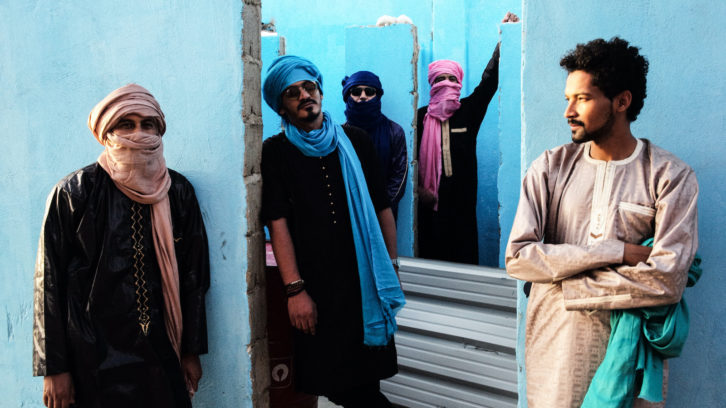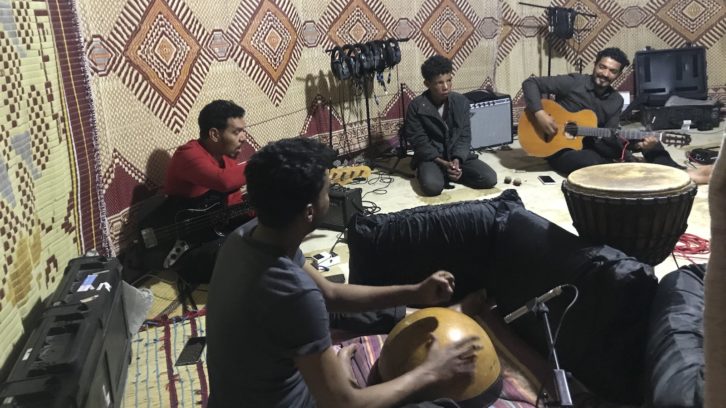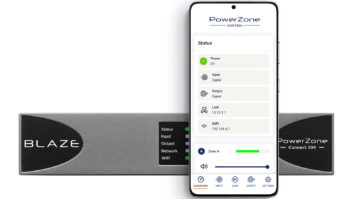
“They’re not playing football,” says engineer Maxime Kosinetz by phone from Paris. He’s describing the community he found in Tamanrasset, Algeria, where he recorded Imarhan’s third album. “Music is their football,” he explains.
Yet, in a place where young people would rather play guitar than soccer, there was no professional studio until Imarhan built one in 2019, to house sessions for their latest release. Both the studio and the album are named Aboogi.
The members of Imarhan are part of the Tuareg population, who inhabit an area of the Sahara desert that stretches from southwest Libya to the bandmembers’ home in southern Algeria and beyond. The band blends traditional acoustic music with contemporary social commentary and timeless emotions. In songs such as “Assossam” (“Shut Us Up”) and “Adar Newlan” (“The Blazing Rocks”), for example, the lyrics address economic and legal challenges faced by citizens of southern Algeria versus the more affluent north, while the music draws on cultural traditions.
Kosinetz has worked on all three of Imarhan’s albums, beginning with the group’s eponymous debut (2016, City Slang). A chance encounter with the band’s producer, Patrick Votan, while the group was recording in Melodium Studio, Montreuil, France, led to an invitation to mix the album. That connection paved the way for him to record their next release, Temet (2018, City Slang), also in France. Aboogi marks the first time that Imarhan have been able to record an entire album on their native soil, and the first time Kosinetz co-produced along with Votan.
FIRST, BUILD A STUDIO
In March 2020, Kosinetz and Votan headed to southern Algeria, where they would stay for a month: one week to help treat and outfit the studio rooms, then three weeks to record the album. Kosinetz recalls that Imarhan had built “two round houses—one for the control room and one for the recording room. The rooms were made of cinder blocks and dried mud, the same color as the earth. The ceiling was a metal frame [covered with] big, dry tree leaves. When we arrived, it was not sounding really good; there were a lot of reflections, so we went to the market and we bought a lot of carpets, duvets—everything we could find to tame the room and [create] isolation between musicians during the recording.”
Kosinetz and the band equipped the studio with a Pro Tools HD Native rig, as well as UA Apollo and Heritage Audio preamps. “We had eight Apollo preamps, two 1073s and six other Neve-style preamps, so 16 channels,” Kosinetz says. “For the mics, they had [Shure] SM57s—a lot—and an AKG 414, which was our room mic. We brought some Beyer 160s and AKG 451s that we used mainly on acoustic guitars, Shure PZM for the calebas, and an [EV] RE20 for the low-tuned percussion. We used [Sennheiser] 441s on vocals; this dynamic, hypercardioid mic with a wide frequency response was perfect for Sadam’s vocals in a live recording situation because it sounds full, with almost no bleed from others.”

RECORDING LIVE IN ALGERIA
“They record everything live, whether it’s one or two guys, or everyone in the band, so the base of the song is always a live recording,” Kosinetz continues. “Then they would add some sparse overdubs, if needed, so it was really important for us to have a nice, close mic with as little bleed as possible to be able to play with the arrangement later.
“The most important part, though, was chasing the vibe of the song; sometimes the guys were sitting one meter apart, and you need to be ready to make edits later. Another thing was, because the studio is in the desert, there’s a lot of dust and we needed to clean the mics almost every day. That’s why we used a lot of sturdy and less-expensive mics.”
Building ‘Home in This World:’ A Tribute to Woody Guthrie’s Dust Bowl Ballads
The five regular members of Imarhan are Iyad Moussa Ben Abderrahmane (also known as Sadam) on lead vocals and lead guitar; guitarist/ vocalist Abdelkader Ourzig; bass player/vocalist Tahar Khaldi; Hicham Bouhasse on percussion, guitars and vocals; and Haiballah Akhamouk on percussion, additional guitars and vocals.
The album also features several guest artists. Japonais, one of the founders of the Tuareg band Tinariwen, sadly passed away in February 2021, but he appears on the love(ish) song “Tamiditin” (“My Girlfriend”). Also, Welsh singer Gruff Rhys sang, played guitar and co-wrote two songs in the studio with the band.
Additional percussion parts and background vocals were recorded later, either in Tamanrasset or in Paris during the mix phase, which happened in Kosinetz’s personal studio.
MIXING IN PARIS
Kosinetz mixes within Pro Tools, using HD Native, Plugin Alliance and FabFilter plug-ins, among others. His monitors are a pair of triedand- true Yamaha NS10s and a pair of ADAM A7x. He says his main goal, however, was to use his tools sparingly, to “let it still sound sweet and warm, like we were in Aboogi Studio—almost no production. I would rather do things like placing microphones far away from the background singers, or from percussion instruments, than do too much later to manipulate the sound.”
Kosinetz says he thoroughly enjoyed his time in southern Algeria, and the Imarhan bandmembers are as much his friends as his clients, even though he speaks mainly French and most of the bandmembers don’t. “We try to understand each other, and usually we do,” he says with a laugh. “Sometimes no, but we work it out. They are all my age—we are all close to 30—and we are all used to being in the studio, so after making three albums, we understand each other.”
Aboogi the album, perfectly captures the band’s skilled and heartfelt approach to Tuareg music. Meanwhile, Aboogi the studio offers the chance for the band to continue recording on its own terms, and to offer new opportunities to other young bands in the region. “They are already using the studio to record younger bands from Tamanrasset,” says Kosinetz. “It’s such a nice thing in a place where you have 12-year-olds who only want to play the guitar.”







